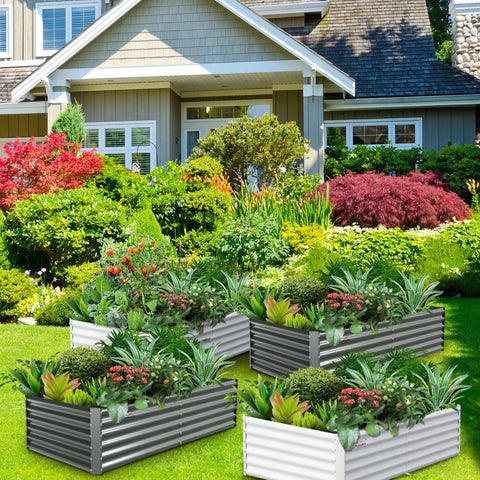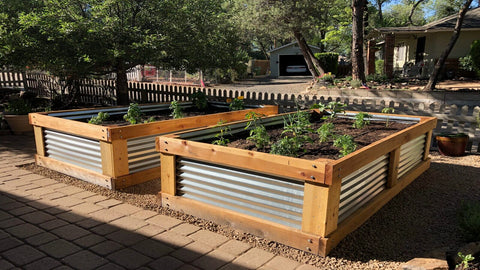Gardening in raised beds is a technique embraced by both novice and experienced gardeners alike. These elevated platforms offer many advantages over traditional in-ground planting. This article explores the 10 best benefits of raised beds for gardening:
1. Enhanced Accessibility
Raised beds transform gardening into an accessible hobby for a broader spectrum of individuals, particularly beneficial for those with physical limitations like the elderly or individuals in wheelchairs. These beds, often built between 12 to 30 inches high, substantially decrease the need to bend over, making gardening a comfortable activity for everyone. This adaptation not only invites more people to enjoy gardening but also significantly lessens the risk of back and knee injuries that can occur from frequent bending and stooping in traditional garden setups.

2. Control Over Soil Quality
Raised beds revolutionize how gardeners approach soil management. By allowing the direct addition of customized soil mixes, gardeners can bypass the often arduous process of amending poor native soil, which might be rocky, depleted, or heavy with clay. This means plants can thrive from the outset in nutrient-rich, well-balanced soil tailored to specific needs. This immediate control over the soil environment speeds up planting and increases the likelihood of a successful garden, as plants get the best possible start.
3. Pest Deterrence
The design of raised beds naturally deters many pests. Elevating the soil makes it more challenging for various ground-level pests like dogs, rabbits, and groundhogs to reach the plants. For smaller burrowing animals, such as gophers and voles, gardeners can integrate a layer of hardware cloth beneath the bed. This mesh barrier prevents pests from tunneling up into the garden, securing the roots of the plants and ensuring the integrity of the garden is maintained without the use of harsh chemicals or complex trapping systems.
4. Flexibility in Placement
Raised beds offer unparalleled flexibility in terms of placement, making them an ideal solution for locations where traditional gardening is a challenge. Whether it's atop contaminated soil, over hard concrete, or on rocky terrain, raised beds can be constructed and filled with a suitable soil mix to create a productive gardening space. This flexibility is particularly crucial in urban settings or reclaimed industrial areas, where the ground may contain toxins or the soil quality is too poor for direct planting. By using raised beds, gardeners can effectively create fertile ground anywhere, circumventing the limitations of their environment.
5. Extended Growing Season

The structure of raised beds provides significant thermal advantages which contribute to an extended growing season. Soil in raised beds is exposed to more direct sunlight and air circulation, allowing it to warm up quicker in the spring and retain heat longer into the fall. This extended period of warmth accelerates seed germination and extends the growing time for plants, often allowing for multiple crop rotations in a single season. In regions with cooler climates, this can be particularly advantageous, providing a head start in spring and a longer harvest period before the first frost.
6. Ease of Weeding
Raised beds significantly simplify the weeding process. By elevating the soil level, gardeners can comfortably access the bed from all sides without the need to bend deeply or stretch. This accessibility not only makes the task less physically demanding but also more efficient. The contained nature of raised beds means that the soil is less likely to be contaminated with weed seeds from surrounding areas, especially when combined with strategic mulching. Mulch covers the soil surface, suppressing weed growth by blocking sunlight and retaining soil moisture. Together, the height and controlled environment of raised beds reduce the frequency and labor intensity of weeding, making garden maintenance more manageable and enjoyable.
7. Improved Drainage
Raised beds significantly enhance the drainage capabilities within a garden, essential for plant health and vigor. By structurally elevating the soil, these beds allow for excess water to swiftly drain away, thus preventing the detrimental conditions of waterlogging that often lead to root diseases such as root rot. This feature is especially advantageous in areas known for their heavy rainfall or where the natural ground consists of compact, poorly draining soil. Gardeners can further customize the soil mix in their raised beds, adjusting the levels of sand, compost, and other materials to optimize the drainage and aeration specifically suited to the needs of their chosen plants. The ability to control soil conditions so directly ensures that moisture levels are maintained within an ideal range, avoiding the pitfalls of both underwatering and waterlogging.
8. Reduced Risk of Plant Damage
The thoughtful design of raised beds minimizes the risk of plant damage, which is common in traditional garden setups. The elevated nature of these beds, along with their well-defined boundaries, acts as a safeguard against accidental damage from garden equipment like hoses and carts or from stepping on plants. This protection is particularly important for safeguarding young, vulnerable seedlings and delicate plants from being crushed or damaged during routine garden maintenance activities such as watering, weeding, or harvesting. Additionally, the clear demarcation of walking paths and plant areas provided by garden beds directs the movement of tools and gardeners, preventing mishaps that can occur when garden spaces are less structured. This not only protects the plants but also contributes to a more orderly and efficient gardening experience.

9. Efficient Garden Planning and Organization
Raised beds excel in enhancing garden organization and planning. With their clear, defined boundaries, these beds allow gardeners to precisely determine the spatial allocation for each plant type, ensuring optimal use of every square inch. This methodical arrangement is particularly advantageous when implementing techniques like crop rotation, which helps prevent soil depletion and control pests and diseases more effectively. Moreover, the organization facilitated by raised beds streamlines the planning of successive plantings, making it simpler to manage seasonal transitions and maintain continuous production. The structured layout not only boosts productivity but also contributes to the garden's visual appeal, making it both a productive and enjoyable space. This level of control and definition simplifies maintenance tasks and enhances the overall gardening experience.
10. Prevention of Soil Erosion
Raised garden beds are strategically effective in combating soil erosion, a common challenge in many gardens, especially those located in regions with frequent heavy rainfall or built on sloped terrain. By confining soil to designated areas enclosed by barriers, these beds prevent the soil from being dispersed by wind and rain. This containment is crucial for maintaining soil integrity and ensuring that valuable nutrients aren't washed away during storms. The result is a more stable gardening environment where soil quality is preserved, and the need for frequent top-ups of soil and nutrients is minimized. Additionally, the retained soil structure helps to support healthy plant growth and development over longer periods, making raised beds an essential component for sustainable gardening practices. This approach not only protects the investment in high-quality soil but also supports the ecological balance within the garden.
Final Words
Raised bed gardening offers a myriad of benefits that make it an appealing choice for gardeners worldwide. From improved accessibility and pest control to enhanced soil management and extended growing seasons, raised beds provide a practical and efficient solution to many of the challenges faced in traditional gardening. Whether you're a seasoned gardener looking to optimize your yield or a beginner seeking a manageable entry into gardening, raised beds offer a compelling solution that marries convenience with productivity.

